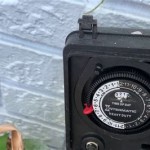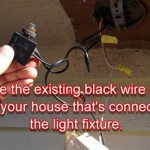Outdoor Motion Sensor Light Keeps Turning On And Off
Outdoor motion sensor lights are designed to enhance security and provide convenience by illuminating areas when movement is detected. However, a common issue that homeowners face is when these lights start turning on and off repeatedly, even when there is no apparent movement. This erratic behavior can be frustrating, create a false sense of alarm, and potentially shorten the lifespan of the light. Understanding the potential causes behind this problem is essential for effective troubleshooting and resolution.
Several factors can contribute to a motion sensor light malfunctioning in this way. These range from simple environmental triggers to more complex electrical issues. A methodical approach to diagnosing the problem is crucial to avoid unnecessary replacements or costly professional repairs. This article will delve into the various reasons why an outdoor motion sensor light might be exhibiting this on-off cycling behavior and offer potential solutions for each.
Environmental Factors Affecting Motion Sensors
Motion sensors, typically Passive Infrared (PIR) sensors, detect changes in infrared radiation, which is emitted by warm objects. While designed to ignore minor fluctuations, certain environmental conditions can mimic the thermal signatures of moving objects, triggering the sensor. These environmental factors are often the culprits behind false positives and can lead to the constant cycling of the light.
One prominent cause is the movement of vegetation. Trees, bushes, and even tall grasses swaying in the wind can create enough variation in infrared signatures to activate the sensor. The leaves and branches heat up and cool down with sunlight and shadows, producing changes that the sensor interprets as movement. Similarly, animals, such as small birds, squirrels, or even insects, can trigger the sensor, particularly if they are close to the sensor's range.
Another environmental factor is direct sunlight or heat sources. If the sensor is exposed to direct sunlight at certain times of the day, the rapid changes in temperature can cause it to trigger. Similarly, heat sources like vents from dryers or air conditioning units can emit warm air that fluctuates, leading to false activations. Reflective surfaces can also redirect sunlight or heat, magnifying the effect on the sensor.
Weather conditions also play a significant role. Heavy rain, snow, or even strong winds can create enough environmental disturbance to trick the sensor. Raindrops falling across the sensor's field of view or snow blowing rapidly can cause fluctuations in infrared radiation. Strong winds can also move objects that are barely within the sensor's range, making them appear to be larger or moving more rapidly.
To mitigate these environmental issues, consider adjusting the sensitivity settings of the motion sensor. Most motion sensor lights have a sensitivity dial that allows users to adjust the range and intensity of movement required to trigger the light. Lowering the sensitivity can reduce the likelihood of the light being triggered by minor disturbances. Additionally, physically repositioning the light to avoid direct sunlight, heat sources, and areas with dense vegetation can be effective. Trimming overgrown bushes and trees near the sensor can also help to reduce false positives.
Electrical Issues Causing Malfunctions
Beyond environmental factors, electrical issues can also be responsible for a motion sensor light turning on and off repeatedly. These electrical problems can range from simple wiring issues to more complex problems with the power supply or the sensor itself.
A loose or faulty wiring connection is a common cause. Over time, connections can loosen due to vibrations, temperature changes, or corrosion. This can create intermittent contact, causing the light to flicker or turn on and off sporadically. Check all wiring connections at the light fixture, junction box, and any related switches or outlets. Ensure that the wires are securely fastened and that there is no corrosion or damage. If any wires appear frayed or damaged, they should be replaced by a qualified electrician.
Another potential electrical issue is voltage fluctuations. A sudden drop or surge in voltage can disrupt the sensor's operation, causing it to malfunction. This can be due to problems with the electrical grid, faulty appliances on the same circuit, or even issues with the transformer supplying power to the light. A voltage tester can be used to check the voltage at the light fixture. If significant fluctuations are detected, consult with an electrician to diagnose and address the underlying electrical issue.
Sometimes, the motion sensor itself can be faulty. Over time, the sensor's internal components can degrade, leading to erratic behavior. This is particularly common in older lights or lights that have been exposed to harsh weather conditions. If all other potential causes have been ruled out, the motion sensor itself may need to be replaced. Replacing the entire light fixture is often the easiest and most cost-effective solution, as motion sensor lights are typically sold as complete units. However, some sensors can be replaced individually, depending on the model.
Furthermore, problems with the light bulb can also contribute to the issue. An incandescent bulb nearing the end of its life can flicker or turn on and off intermittently. This flickering can sometimes be enough to trigger the motion sensor, especially if the sensor is set to a high sensitivity. Replace the bulb with a new one of the correct wattage to see if this resolves the problem. It is also important to ensure that the bulb is compatible with the motion sensor light. Some sensors can be sensitive to the type of bulb used, such as LED or halogen, and may require specific bulb types for optimal performance.
Finally, interference from other electronic devices can sometimes cause motion sensors to malfunction. Radio Frequency Interference (RFI) from nearby devices can disrupt the sensor's signal, leading to false triggers. This is more common with wireless motion sensors. If you suspect RFI is the cause, try moving the light away from potential sources of interference, such as wireless routers, cordless phones, or other electronic devices. Using shielded wiring can also help to reduce interference.
Sensor Settings and Adjustments
The settings of the motion sensor itself play a crucial role in its performance and can be a significant factor in why a light keeps turning on and off. Motion sensors typically have several adjustable settings, including sensitivity, range, and duration. Understanding how these settings work and adjusting them appropriately can help to eliminate false triggers and ensure the light operates as intended.
Sensitivity, as mentioned earlier, determines how much movement is required to trigger the light. A higher sensitivity setting will detect even minor movements, while a lower setting will require more significant movement. If the light is being triggered by environmental factors like wind or small animals, lowering the sensitivity can significantly reduce false positives. Start by lowering the sensitivity to its lowest setting and gradually increase it until the light is triggered only by desired movements.
The range setting determines the distance within which the sensor will detect movement. A longer range will cover a larger area, but it also increases the likelihood of being triggered by unwanted movements. Conversely, a shorter range will limit the detection area but may not cover the desired area effectively. Adjust the range to cover the area where you want to detect movement, while minimizing the areas where false triggers are likely to occur. Most sensors have a range adjustment knob or switch that allows users to modify the detection distance.
The duration setting determines how long the light stays on after being triggered. A longer duration will keep the light on for a longer period, which can be useful for providing extended illumination. However, it can also lead to unnecessary energy consumption if the light is being triggered frequently. A shorter duration will turn the light off more quickly, conserving energy but potentially requiring more frequent activations. Choose a duration that balances the need for illumination with energy efficiency. Experiment with different duration settings to find the optimal setting for your needs.
Many motion sensor lights also have a test mode. This mode allows you to test the sensor's functionality and adjust the settings without having to wait for nighttime. In test mode, the light will typically turn on for a short period after detecting movement, regardless of the duration setting. This allows you to quickly assess the sensor's performance and make adjustments as needed. Use the test mode to fine-tune the sensitivity, range, and duration settings until the light is working correctly.
Some advanced motion sensor lights also offer additional features, such as adjustable detection zones or masking. Detection zones allow you to define specific areas where the sensor should detect movement, while ignoring other areas. Masking allows you to block out specific areas from the sensor's field of view, preventing it from being triggered by unwanted movements. These features can be particularly useful for addressing persistent false triggers caused by environmental factors or specific objects.
Regularly cleaning the sensor lens is also essential for optimal performance. Dust, dirt, and debris can accumulate on the lens, interfering with the sensor's ability to detect movement accurately. Use a soft, damp cloth to gently clean the lens, removing any buildup that may be affecting its performance. Avoid using harsh chemicals or abrasive cleaners, as these can damage the lens.
By understanding the various settings and adjustments available on a motion sensor light and taking the time to fine-tune them, homeowners can significantly reduce the likelihood of false triggers and ensure that the light operates reliably and efficiently. Consider consulting the manufacturer's instructions for specific guidance on adjusting the settings for your particular model of motion sensor light.

Electrical Motion Sensor Lights Constantly On Only Or Off Home Improvement Stack Exchange
My Outdoor Security Light Won T Turn Off George Brazil Plumbing Electrical

How To Stop A Motion Sensor Light From Turning Off Rayzeek

How To Stop A Motion Sensor Light From Turning Off Rayzeek

How To Make A Motion Sensor Light Stay On Rayzeek

How To Stop A Motion Sensor Light From Turning Off Rayzeek

Motion Sensor Lights Tips To Reset Detector

How To Install Automatic Day And Night Light Sensor Easy Electrical Diy For Your Outdoor Lights

Ge Led Motion Sensor Light Bulb Par38 Outdoor Security Floodlight Daylight

Here S Why Your Motion Sensor Lights Aren T Turning On Us Electric







